The Geomechanical and Fault Activation Modeling during CO2 Injection into Deep Minjur Reservoir, Eastern Saudi Arabia
Abstract
:1. Introduction
2. Governing Equations
2.1. CO2 Flow Equations
2.2. Deformation Equations
2.3. Fault Permeability Equations
3. Numerical Modeling Scheme in COMSOL and CMG-GEM
4. Results and Discussion
4.1. Reservoir Pore Pressure
4.2. Ground Vertical Displacement (Uplift)
4.3. Fault Permeability Variation
5. Stability Analysis
6. Conclusions
- As CO2 is injected into the reservoir, the magnitude of the pore pressure increases, with a maximum rate of increase during the initial injection period due to a large pressure difference between the base reservoir and injected CO2. Furthermore, the magnitude of the pressure buildup is also dependent on the variation of the injection pressure. In the presence of geological faults in the reservoir and caprock, the excessive increase in the pore pressure will activate the faults and CO2 will be leaked to the overburden layers. The leakage of the pressurized CO2 will cause an increase in the pressure magnitude of the overburden layers.
- The injection of CO2 will cause the reservoir’s structure to experience deformations. As CO2 continues to be injected, the reservoir will be volumetrically expanded. The coupling between pore pressure and stresses will cause an increase in stress magnitudes. Due to the restriction of the deformation of the reservoir in horizontal and downward vertical directions, the reservoir movement is only possible in the upward vertical direction. The vertical movement of the reservoir and caprock causes ground uplift during CO2 injection. The increase in the injection depth will be helpful in reducing the magnitude of ground uplift. The ground uplift will be maximum just above the CO2 injection port in the absence of the fault in the reservoir, whereas, in the presence of the geological fault, the ground uplift will be maximum just above the CO2 leakage point.
- The Mohr–Coulomb failure criterion shows that the reservoir’s stability is highly dependent on the excessive increase in pore pressure during CO2 injection. The excessive increase in pore pressure in the absence of geological faults will move the reservoir closer to the failure envelope but in the presence of geological faults, the reservoir will reach to the failure envelope and the faults will be activated.
Author Contributions
Funding
Acknowledgments
Conflicts of Interest
References
- Leung, D.Y.; Caramanna, G.; Maroto-Valer, M.M. An overview of current status of carbon dioxide capture and storage technologies. Renew. Sustain. Energy Rev. 2014, 39, 426–443. [Google Scholar] [CrossRef] [Green Version]
- Rubin, E.S.; Davison, J.E.; Herzog, H.J. The cost of CO2 capture and storage. Int. J. Greenh. Gas Control 2015, 40, 378–400. [Google Scholar]
- Selma, L.; Seigo, O.; Dohle, S.; Siegrist, M. Public perception of carbon capture and storage (CCS): A review. Renew. Sustain. Energy Rev. 2014, 38, 848–863. [Google Scholar] [CrossRef]
- Bahrami, A.; Jamialahmadi, M.; Moghadasi, J.; Alimohammadi, N. Simulation study of carbon dixoide sequestration potential of the Mary Lee coal zone, Black Warrior basin. Environ. Earth Sci. 2013, 70, 2501–2509. [Google Scholar]
- Gibbins, J.; Chalmers, H. Carbon capture and storage. Energy Policy 2008, 36, 4317–4322. [Google Scholar] [CrossRef] [Green Version]
- Folk, R.L.; Andrews, P.B.; Lewis, D. Detrital sedimentary rock classification and nomenclature for use in New Zealand. N. Z. J. Geol. Geophys. 1970, 13, 937–968. [Google Scholar] [CrossRef] [Green Version]
- Pan, P.; Wu, Z.; Feng, X.; Yan, F. Geomechanical modeling of CO2 geological storage: A review. J. Rock Mech. Geotech. Eng. 2016, 8, 936–947. [Google Scholar]
- Ringrose, P.; Mathieson, A.; Wright, I.; Selama, F.; Hansen, O.; Bissell, R.; Saoula, N.; Midgley, J. The In Salah CO2 Storage Project: Lessons Learned and Knowledge Transfer. Energy Procedia 2013, 37, 6226–6236. [Google Scholar] [CrossRef] [Green Version]
- Rutqvist, J.; Cappa, F.; Rinaldi, A.P.; Godano, M. Modeling of induced seismicity and ground vibrations associated with geologic CO2 storage, and assessing their effects on surface structures and human perception. Int. J. Greenh. Gas Control 2014, 24, 64–77. [Google Scholar] [CrossRef]
- Rinaldi, A.P.; Vilarrasa, V.; Rutqvist, J.; Cappa, F. Fault reactivation during CO2 sequestration: Effects of well orientation on seismicity and leakage. Greenh. Gases Sci. Technol. 2015, 5, 645–656. [Google Scholar] [CrossRef]
- Birkholzer, J.T.; Cihan, A.; Zhou, Q. Impact-driven pressure management via targeted brine extraction—Conceptual studies of CO2 storage in saline formations. Int. J. Greenh. Gas Control 2012, 7, 168–180. [Google Scholar] [CrossRef] [Green Version]
- Martinez, M.J.; Newell, P.; Bishop, J.E.; Turner, D. Coupled multiphase flow and geomechanics model for analysis of joint reactivation during CO2 sequestration operations. Int. J. Greenh. Gas Control 2013, 17, 148–160. [Google Scholar] [CrossRef]
- Rutqvist, J.; Birkholzer, J.; Cappa, F.; Tsang, C.-F. Estimating maximum sustainable injection pressure during geological sequestration of CO2 using coupled fluid flow and geomechanical fault-slip analysis. Energy Convers. Manag. 2007, 48, 1798–1807. [Google Scholar] [CrossRef] [Green Version]
- Vilarrasa, V.; Carrera, J. Geologic carbon storage is unlikely to trigger large earthquakes and reactivate faults through which CO2 could leak. Proc. Natl. Acad. Sci. USA 2015, 112, 5938–5943. [Google Scholar] [PubMed] [Green Version]
- Yamamoto, S.; Miyoshi, S.; Sato, S.; Suzuki, K. Study on Geomechanical Stability of the Aquifer-caprock System During CO2 Sequestration by Coupled Hydromechanical Modelling. Energy Procedia 2013, 37, 3989–3996. [Google Scholar] [CrossRef] [Green Version]
- Boosari, S.S.H.; Aybar, U.; Eshkalak, M.O. CO2 storage and sequestration in unconventional shale reservoirs. J. Geosci. Environ. Prot. 2015, 3, 7. [Google Scholar]
- Matter, J.M.; Takahashi, T.; Goldberg, D. Experimental evaluation of in situ CO2-water-rock reactions during CO2 injection in basaltic rocks: Implications for geological CO2 sequestration. Geochem. Geophys. Geosystems 2007, 1–19. [Google Scholar] [CrossRef]
- Vidas, H.; Hugman, B.; Chikkatur, A.; Venkatesh, B. Analysis of the Costs and Benefits of CO2 Sequestration on the U.S. Outer Continental Shelf; OCS Study BOEM 2012-100; ICF International: Herndon, VA, USA, 2012. [Google Scholar]
- Bissell, R.; Vasco, D.; Atbi, M.; Hamdani, M.; Okwelegbe, M.; Goldwater, M. A full field simulation of the in Salah gas production and CO2 storage project using a coupled geo-mechanical and thermal fluid flow simulator. Energy Procedia 2011, 4, 3290–3297. [Google Scholar] [CrossRef] [Green Version]
- Davis, E.J. Interpretation of CO2 Sequestration-Induced Surface Deformation over KB-502 at Krechba, Algeria. In Proceedings of the SPE Annual Technical Conference and Exhibition, Denver, CO, USA, 20 October–2 November 2011. [Google Scholar]
- Eiken, O.; Ringrose, P.; Hermanrud, C.; Nazarian, B.; Torp, T.A.; Høier, L. Lessons learned from 14 years of CCS operations: Sleipner, In Salah and Snøhvit. Energy Procedia 2011, 4, 5541–5548. [Google Scholar] [CrossRef] [Green Version]
- Trupp, M.; Frontczak, J.; Torkington, J. The gorgon CO2 injection project—2012 update. Energy Procedia 2013, 37, 6237–6247. [Google Scholar] [CrossRef] [Green Version]
- Vilarrasa, V.; Bolster, D.; Olivella, S.; Carrera, J. Coupled hydromechanical modeling of CO2 sequestration in deep saline aquifers. Int. J. Greenh. Gas Control 2010, 4, 910–919. [Google Scholar] [CrossRef] [Green Version]
- Evans, J.P.; Forster, C.B.; Goddard, J.V. Permeability of fault-related rocks, and implications for hydraulic structure of fault zones. J. Struct. Geol. 1997, 19, 1393–1404. [Google Scholar] [CrossRef]
- Holzbecher, E. Poroelasticity benchmarking for FEM on analytical solutions. In Proceedings of the 2013 COMSOL Conference in Rotterdam, Rotterdam, The Netherlands, 23–25 October 2013; pp. 1–7. [Google Scholar]
- Jourde, H.; Flodin, E.A.; Aydin, A.; Durlofsky, L.J.; Wen, X.-H. Computing permeability of fault zones in eolian sandstone from outcrop measurements. AAPG Bull. 2002, 86, 1187–1200. [Google Scholar] [CrossRef] [Green Version]
- Khan, S.; Al-Shuhail, A.; Khulief, Y. Numerical modeling of the geomechanical behavior of Ghawar Arab-D carbonate petroleum reservoir undergoing CO2 injection. Environ. Earth Sci. 2016, 75, 1499. [Google Scholar] [CrossRef]
- Khan, S.; Khulief, Y.; Al-Shuhail, A. The effect of injection well arrangement on CO2 injection into carbonate petroleum reservoir. Int. J. Glob. Warm. 2018, 14, 462–487. [Google Scholar]
- Nordbotten, J.M.; Celia, M.A.; Bachu, S. Injection and Storage of CO2 in Deep Saline Aquifers: Analytical Solution for CO2 Plume Evolution During Injection. Transp. Porous Media 2005, 58, 339–360. [Google Scholar] [CrossRef]
- Rutqvist, J.; Vasco, D.W.; Myer, L. Coupled reservoir-geomechanical analysis of CO2 injection and ground deformations at In Salah, Algeria. Int. J. Greenh. Gas Control 2010, 4, 225–230. [Google Scholar] [CrossRef] [Green Version]
- Jia, B.; Tsau, J.S.; Barati, R. A review of the current progress of CO2 injection EOR and carbon storage in shale oil reservoirs. Fuel 2019, 236, 404–427. [Google Scholar] [CrossRef]
- Ajayi, T.; Gomes, J.S.; Bera, A. A review of CO2 storage in geological formations emphasizing modeling, monitoring and capacity estimation approaches. Pet. Sci. 2019, 16, 1028–1063. [Google Scholar] [CrossRef] [Green Version]
- Siqueira, T.A.; Iglesias, R.S.; Ketzer, J.M. Carbon dioxide injection in carbonate reservoirs—a review of CO2-water-rock interaction studies. Greenh. Gas Sci. Technol. 2017, 7, 802–816. [Google Scholar]
- Cao, C.; Liu, H.; Hou, Z.; Mehmood, F.; Liao, J.; Feng, W. A review of CO2 storage in view of safety and cost-effectiveness. Energies 2020, 13, 600. [Google Scholar] [CrossRef] [Green Version]
- Bjørnarå, T.I.; Aker, E.; Skurtveit, E. Safe Storage Parameters During CO2 Injection Using Coupled Reservoir-Geomechanical Analysis. In Proceedings of the COMSOL Conference, Milan, Italy, 14–16 October 2009. [Google Scholar]
- Curnow, J.S.; Tutuncu, A.N. Coupled geomechanics and fluid flow model for production optimization in naturally fractured shale reservoirs. In Proceedings of the SEG Technical Program Expanded Abstracts, Vancouver, BC, Canada, September 2015; pp. 399–403. [Google Scholar]
- Al-Shuhail, A.; Alshuhail, A.A.; Khulief, Y.A.; Salam, S.A.; Chan, S.A.; Ashadi, A.L.; Al-Lehyani, A.F.; Almubarak, A.M.; Khan, M.Z.U.; Khan, S.; et al. KFUPM Ghawar digital viscoelastic seismic model. Arab. J. Geosci. 2019, 12, 245. [Google Scholar] [CrossRef]
- Kazemi, H.; Vestal, C.R.; Shank, D.G. An efficient multi component numerical simulator. Soc. Pet. Eng. J. 1978, 18, 355–368. [Google Scholar]
- Anjani, K.; Varun, P. The Role of Coupled Geomechanical Modeling in Reservoir Simulation. Calgary, Alberta. 1998. Available online: https://www.cmgl.ca/events/webinar-coupled-geomechanics (accessed on 11 November 2020).
- GEM Advanced Compositional Reservoir Simulator: User Guide. Calgary. Available online: https://www.cmgl.ca/gem (accessed on 11 November 2020).
- Barton, C.A.; Zoback, M.D.; Moos, D. Fluid flow along potentially active faults in crystalline rock. Geology 1995, 23, 683–686. [Google Scholar] [CrossRef]
- Tran, D.; Buchanan, W.L.; Nghiem, L.X. Improved Gridding Technique for Coupling Geomechanics to Reservoir Flow. SPE J. 2010, 15, 64–75. [Google Scholar] [CrossRef]
- Sahimi, M. Flow and Transport in Porous Media and Fractured Rock: From Classical Methods to Modern Approaches; Wiley: Weinheim, Germany, 2011. [Google Scholar]
- Chowdhury, S.; Al-Zahrani, M. Characterizing water resources and trends of sector wise water consumptions in Saudi Arabia. J. King Saud Univ.-Eng. Sci. 2015, 27, 68–82. [Google Scholar] [CrossRef] [Green Version]
- Tan, X.; Konietzky, H. Numerical study of variation in Biot’s coefficient with respect to microstructure of rocks. Tectonophysics 2014, 610, 59–171. [Google Scholar]
- Al Ansari, Y.; Fateh, A.; Shehab, A.; Almoulani, G.; Ahmed, A.; Thampi, S. Hanifa-Tuwaiq Mountain Zone: The Edge between Conventional and Unconventional Systems? In Proceedings of the 12th Middle East Geosciences Conference and Exhibition (GEO-2016), Manama, Bahrain, 7–10 March 2016; pp. 1–14. [Google Scholar]
- Afifi, A.M. Ghawar: The anatomy of the world’s largest oil field. AAPG Search Discov. 2005. Available online: http://www.searchanddiscovery.com/documents/2004/afifi01/images/affifi01.pdf (accessed on 11 November 2020).
- Heidbach, O.; Tingay, M.; Barth, A.; Reinecker, J.; Kurfeß, D.; Müller, B. The 2008 Database Release of World Stress Map Project; Commission for the Geological Map of the World: Paris, France, 2008. [Google Scholar] [CrossRef]
- Martin, A.Z. Late Permian to Holocene paleofacies evolution of the Arabian Plate and its hydrocarbon occurrences. GeoArabia 2001, 6, 445–504. [Google Scholar]
- Robert, B. Regional depositional history, stratigraphy and palaeo geography of the Shu’aiba. GeoArabia 2007, 12, 135–152. [Google Scholar]
- Ewy, R. Wellbore-stability predictions by use of a modified lade criterion. SPE Drill. Complet. 1999, 14, 85–91. [Google Scholar] [CrossRef]
- Colmenares, L.B.; Zoback, M.D. A statistical evaluation of intact rock failure criteria constrained by polyaxial test data for five different rocks. Int. J. Rock Mech. Min. Sci. 2002, 39, 695–729. [Google Scholar] [CrossRef]
- Fjær, E.; Ruistuen, H. Impact of the intermediate principal stress on the strength of heterogeneous rock. J. Geophys. Res. Solid Earth 2002, 107, 1–42. [Google Scholar] [CrossRef] [Green Version]
- Benz, T.; Schwab, R. A quantitative comparison of six rock failure criteria. Int. J. Rock Mech. Min. Sci. 2008, 45, 1176–1186. [Google Scholar] [CrossRef]
- Mogi, K. Effect of the intermediate principal stress on rock failure. J. Geophys. Res. 1967, 72, 5117–5131. [Google Scholar] [CrossRef]
- Handin, J.; Heard, H.A.; Magouirk, J.N. Effects of the intermediate principal stress on the failure of limestone, dolomite, and glass at different temperatures and strain rates. J. Geophys. Res. 1967, 72, 611–640. [Google Scholar] [CrossRef]
- Takahashi, M.; Koide, H. Effect of the intermediate principal stress on strength and deformation behavior of sedimentary rocks at the depth shallower than 2000 m. In Proceedings of the ISRM International Symposium, Pau, France, 30 August–2 September 1989. [Google Scholar]
- Chang, C.; Haimson, B. True triaxial strength and deformability of the German Continental Deep Drilling Program (KTB) deep hole amphibolite. J. Geophys. Res. Solid Earth 2000, 105, 18999–19013. [Google Scholar] [CrossRef]
- Hoek, E.; Brown, E.T. Empirical strength criterion for rock masses. J. Geotech. Geoenviron. 1980, 106, 1013–1035. [Google Scholar]
- Lade, P.V. Elasto-plastic stress-strain theory for cohesionless soil with curved yield surfaces. Int. J. Solids Struct. 1977, 13, 1019–1035. [Google Scholar] [CrossRef]
- Mehranpour, M.H.; Kulatilake, P.H.S.W. Comparison of six major intact rock failure criteria using a particle flow approach under true-triaxial stress condition. Geomech. Geophys. Geo-Energy Geo-Resour. 2016, 2, 203–229. [Google Scholar] [CrossRef] [Green Version]
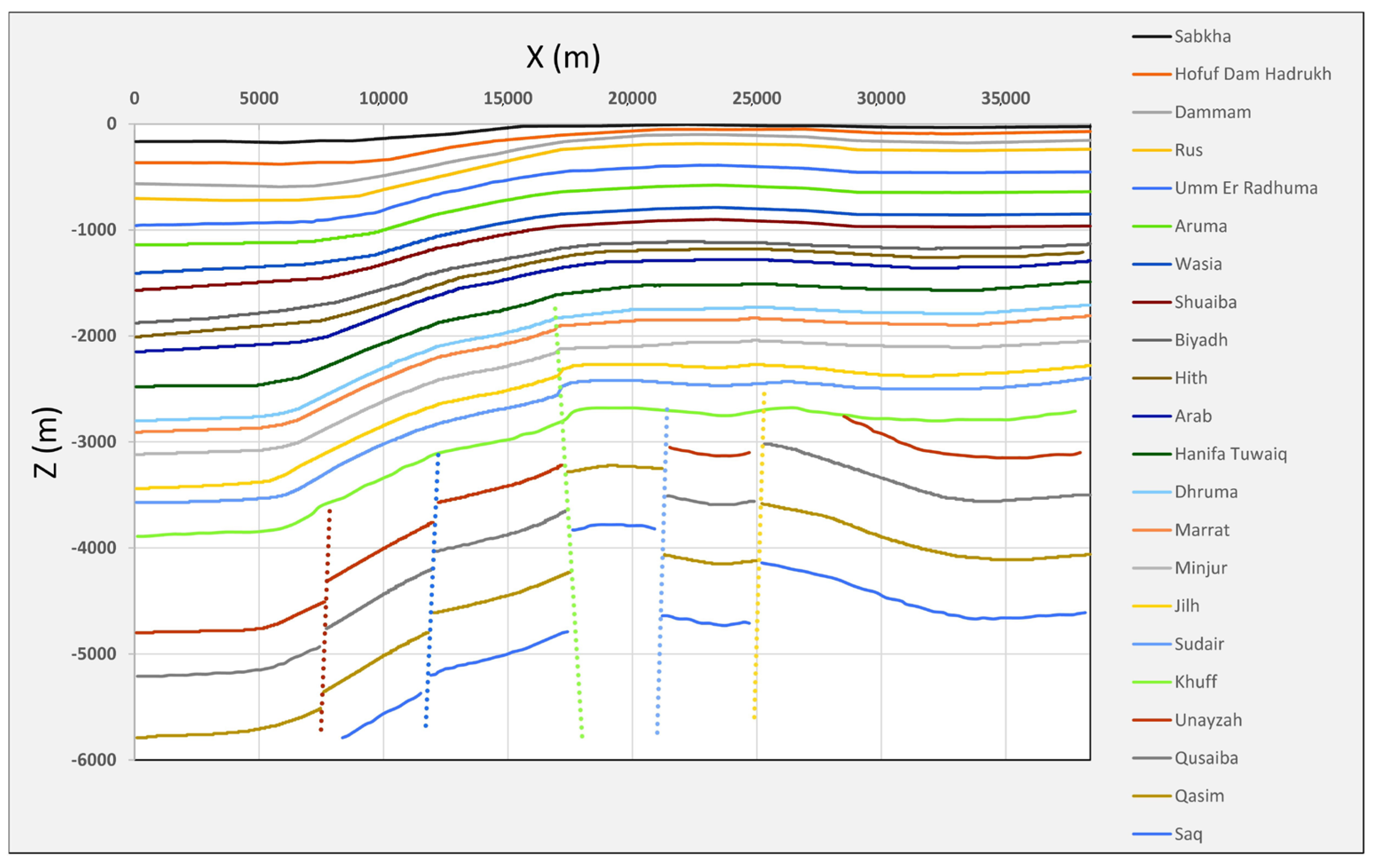
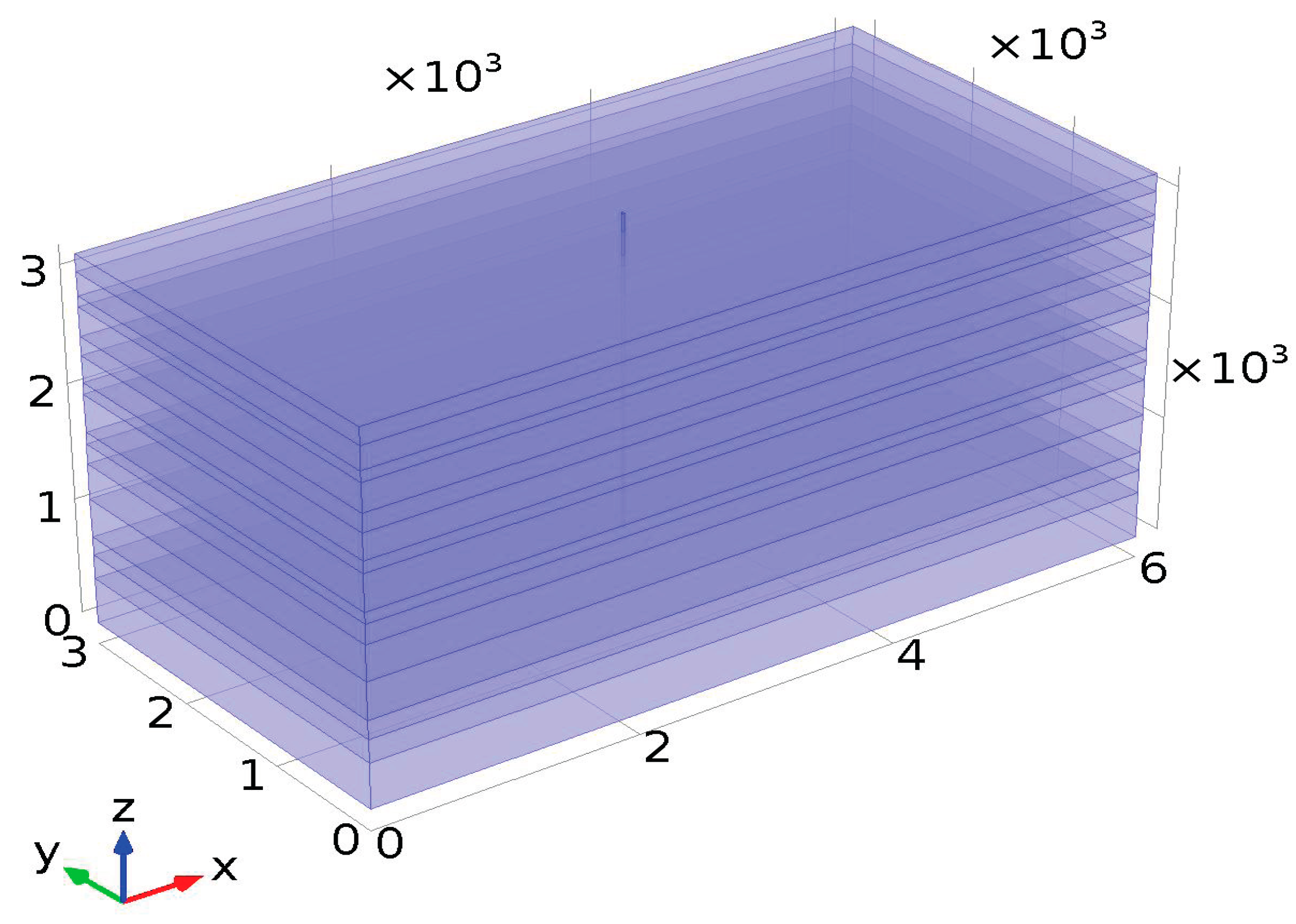
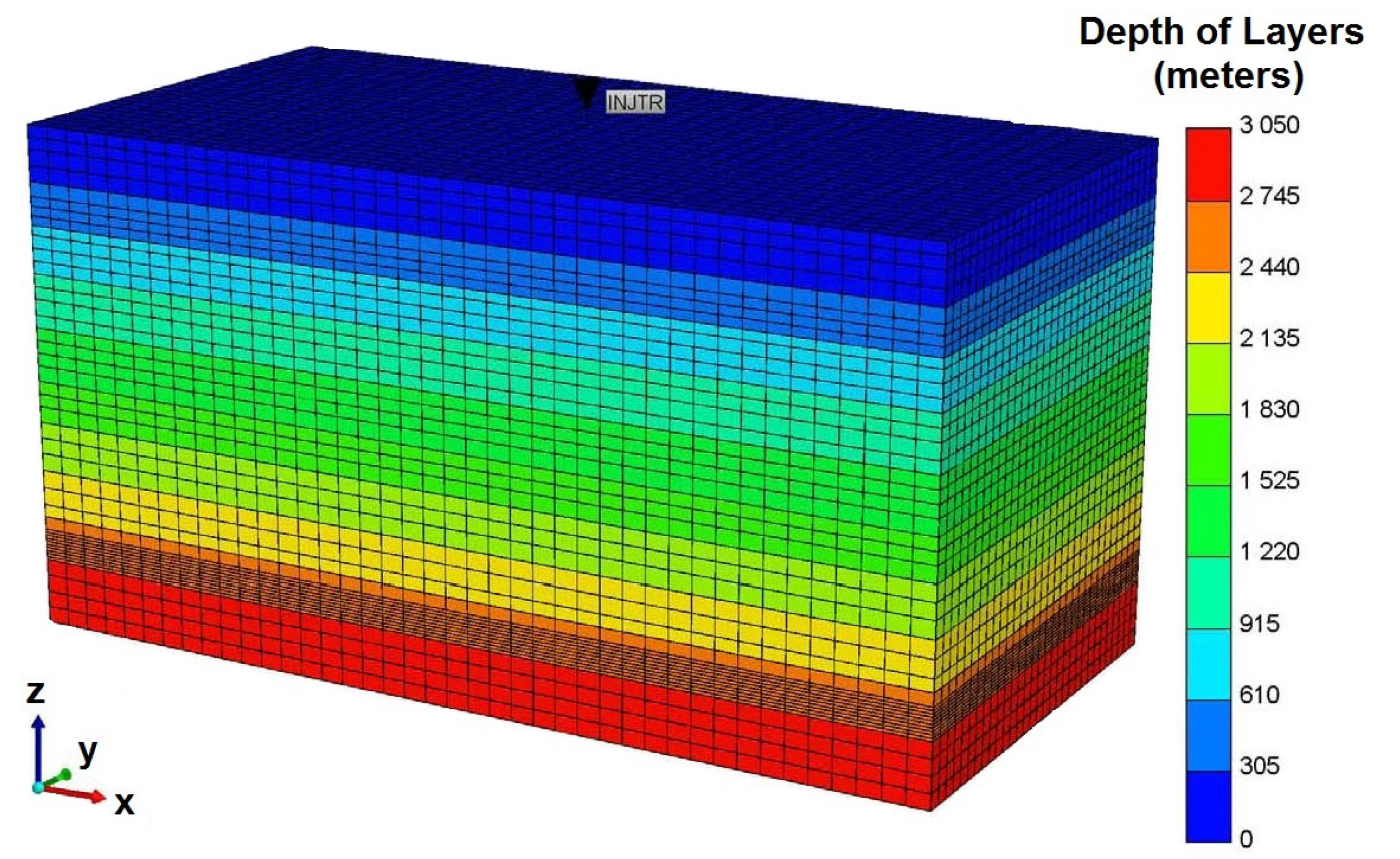
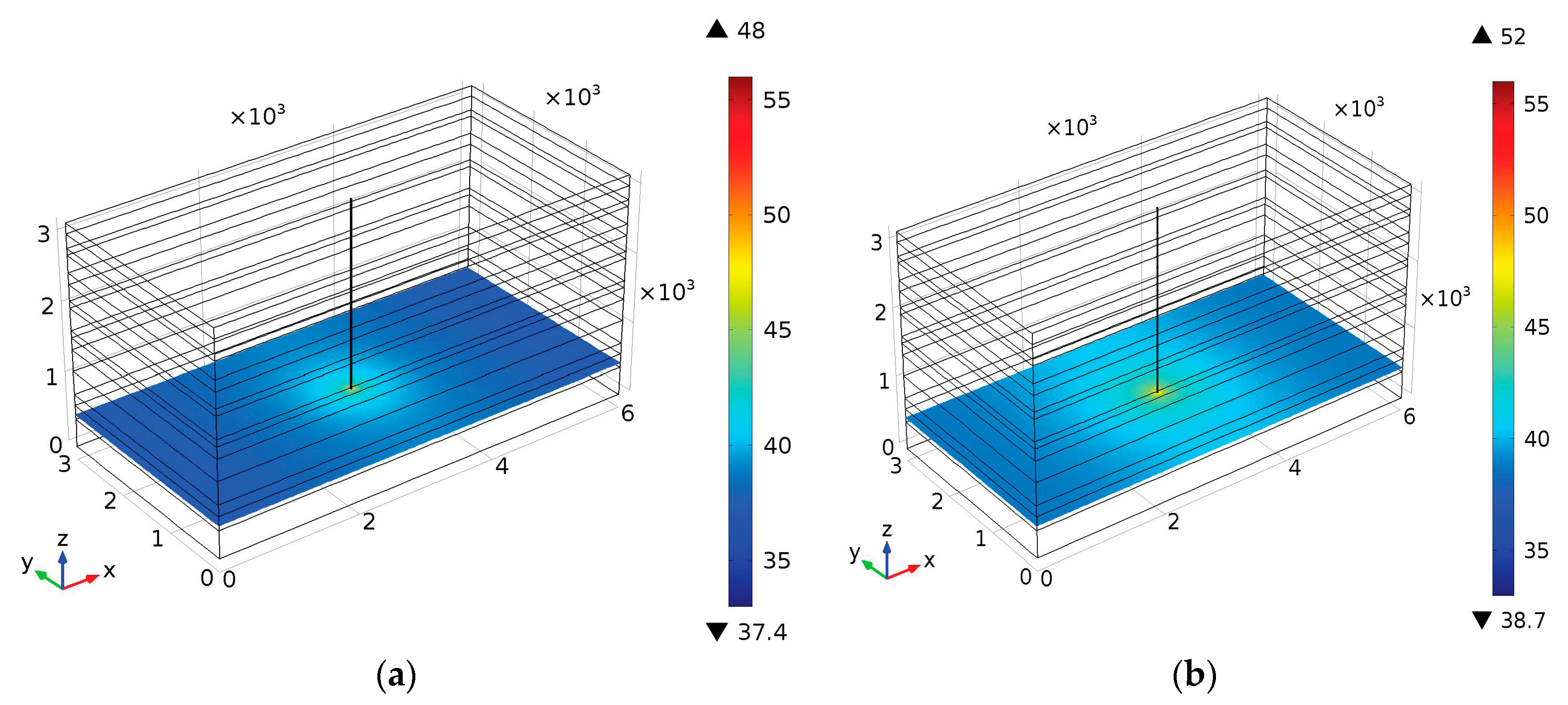
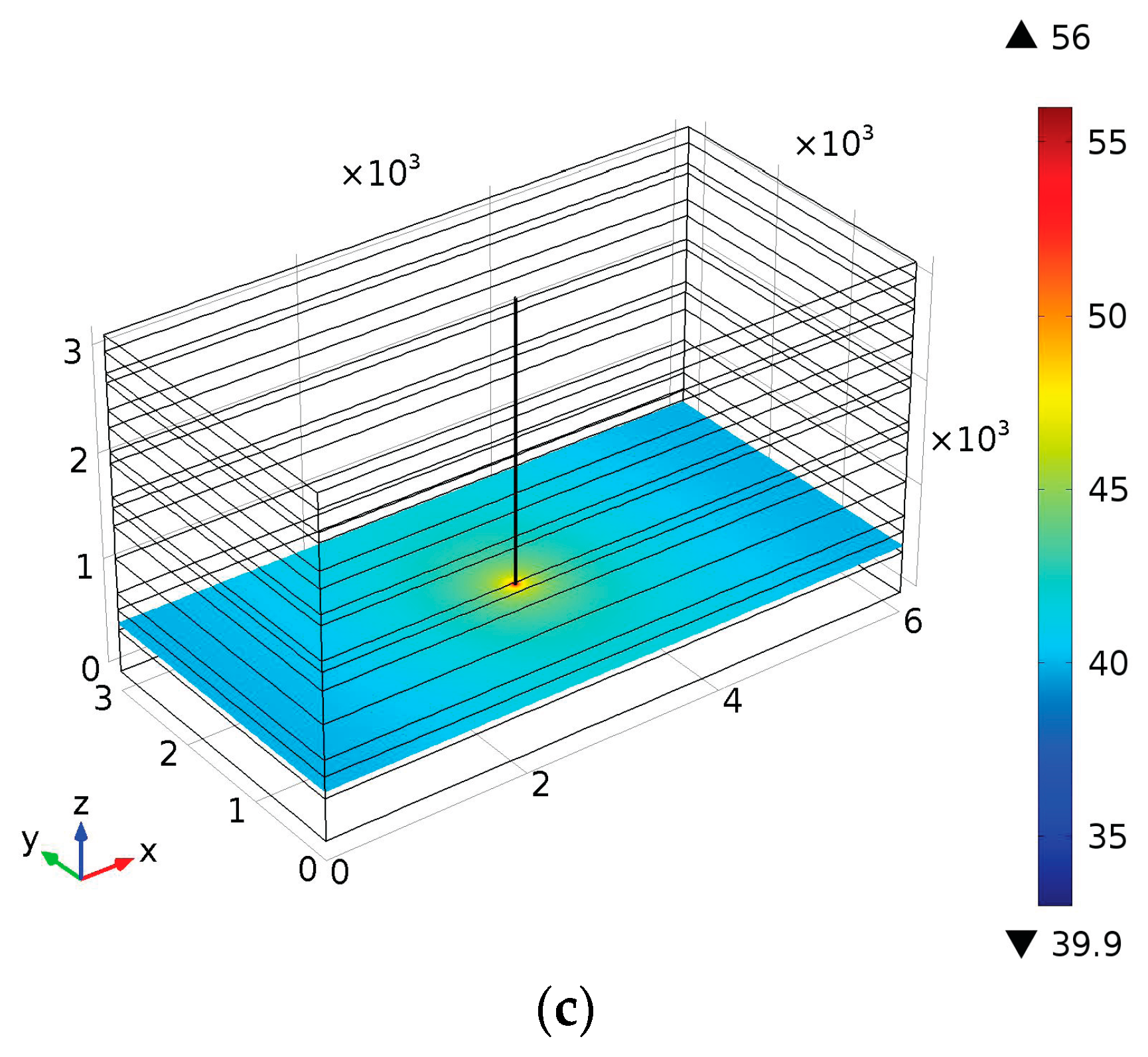

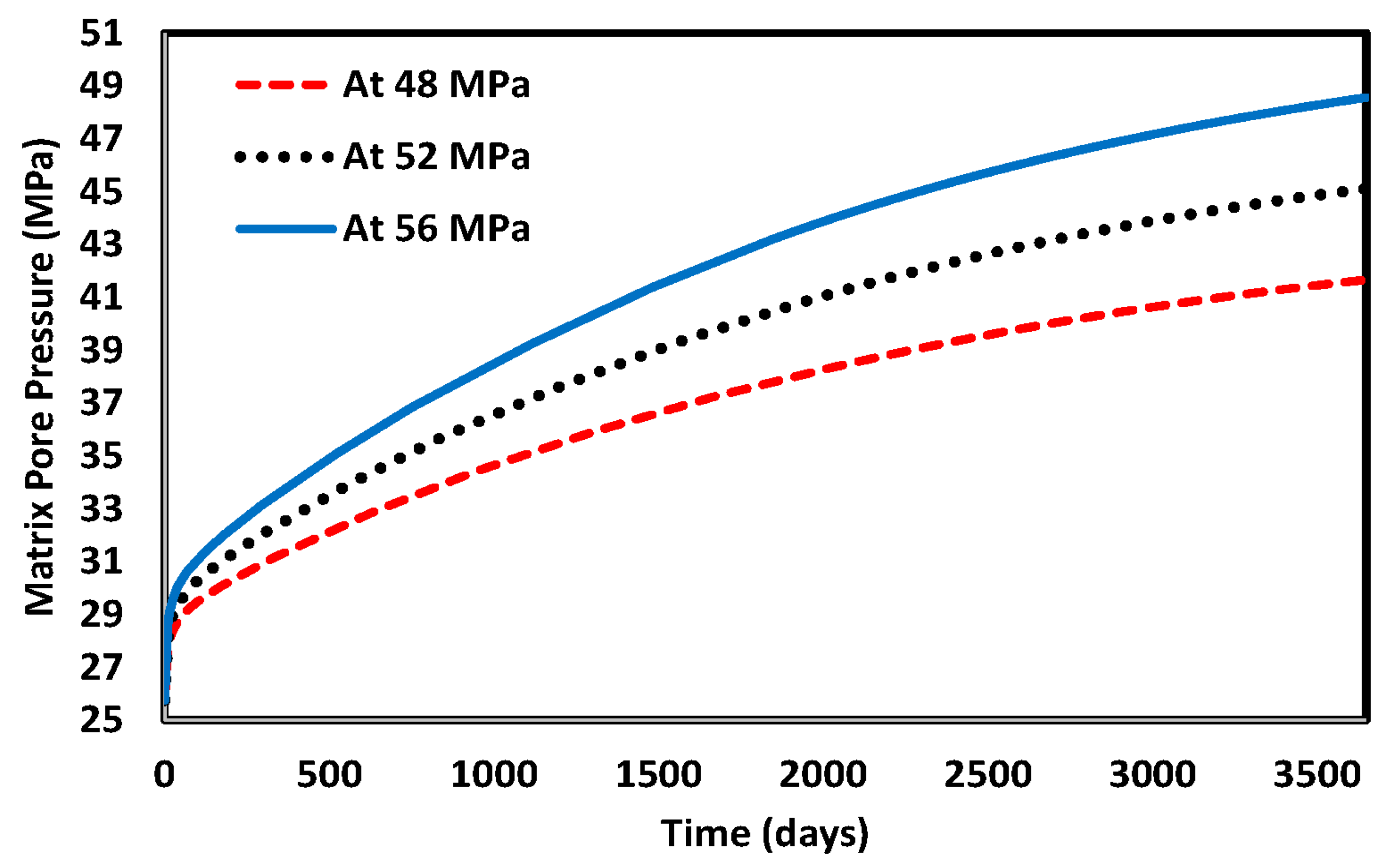
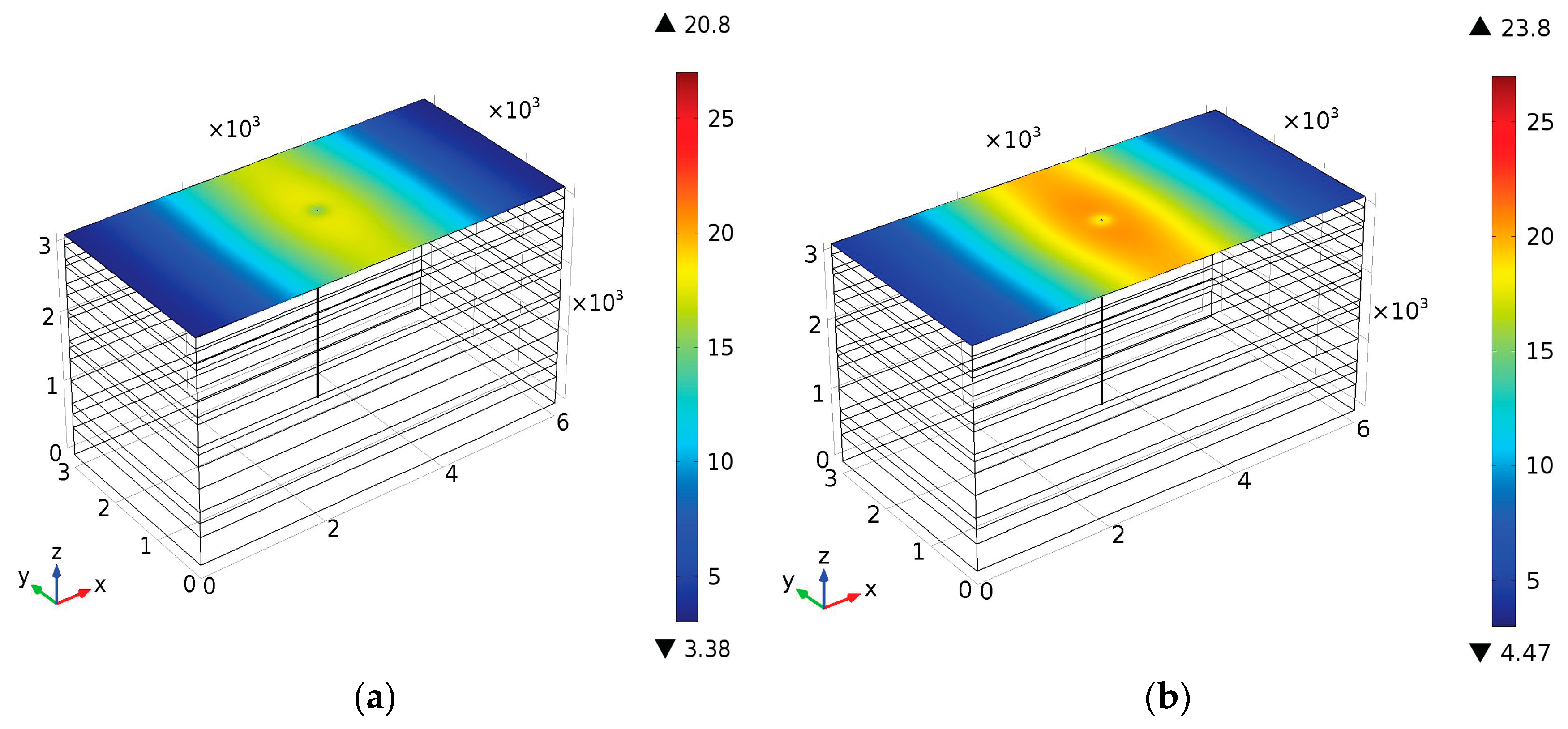

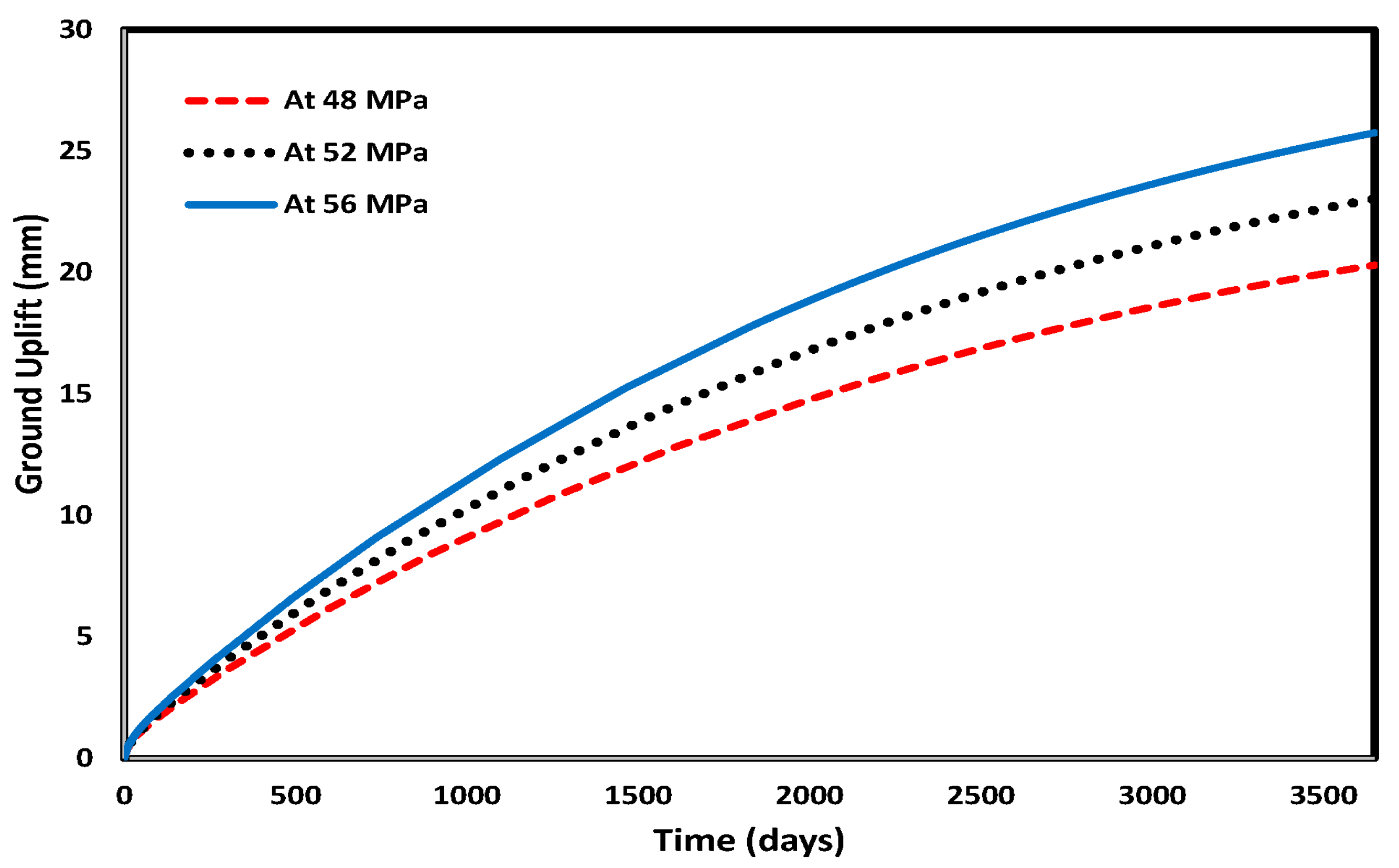
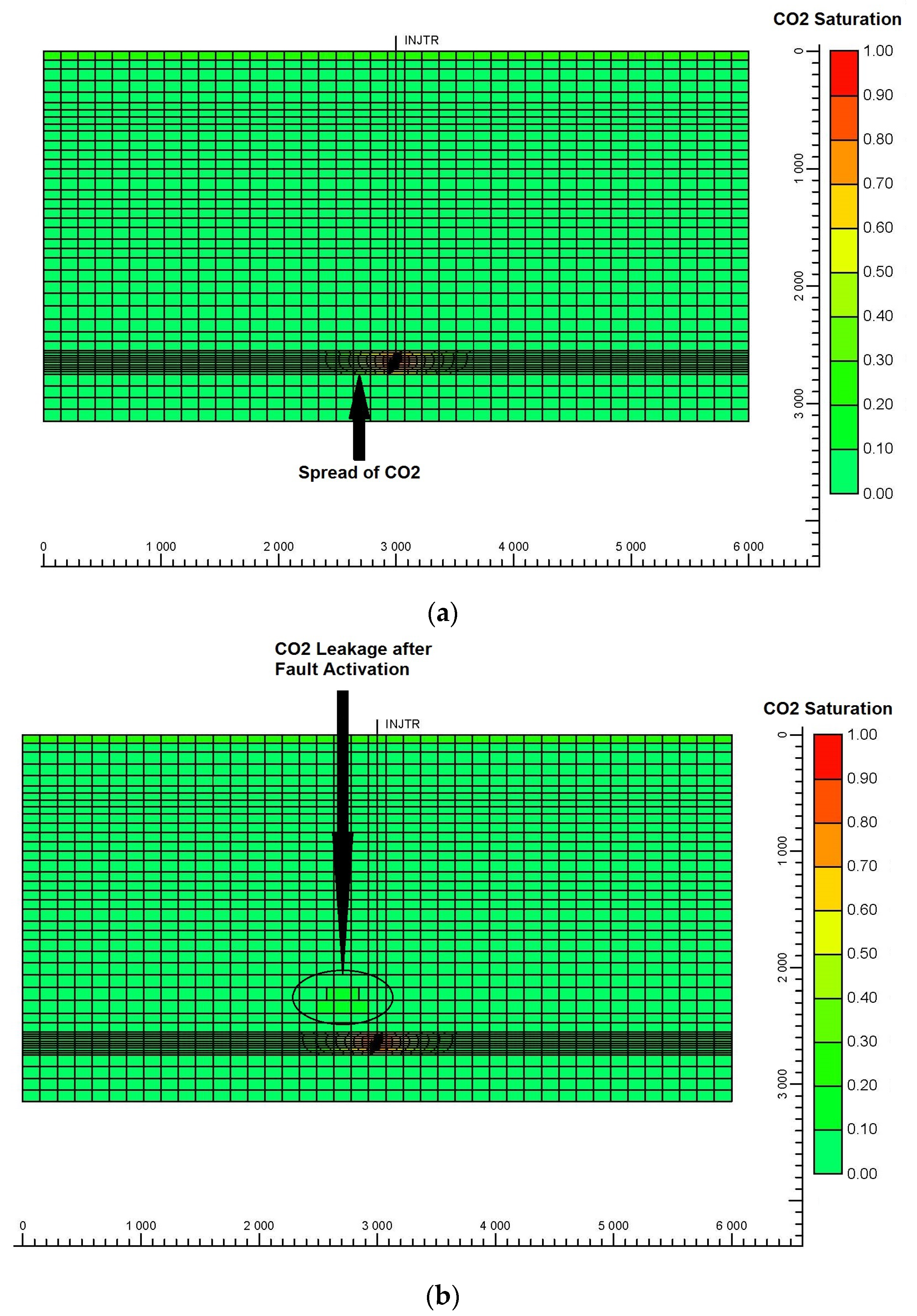

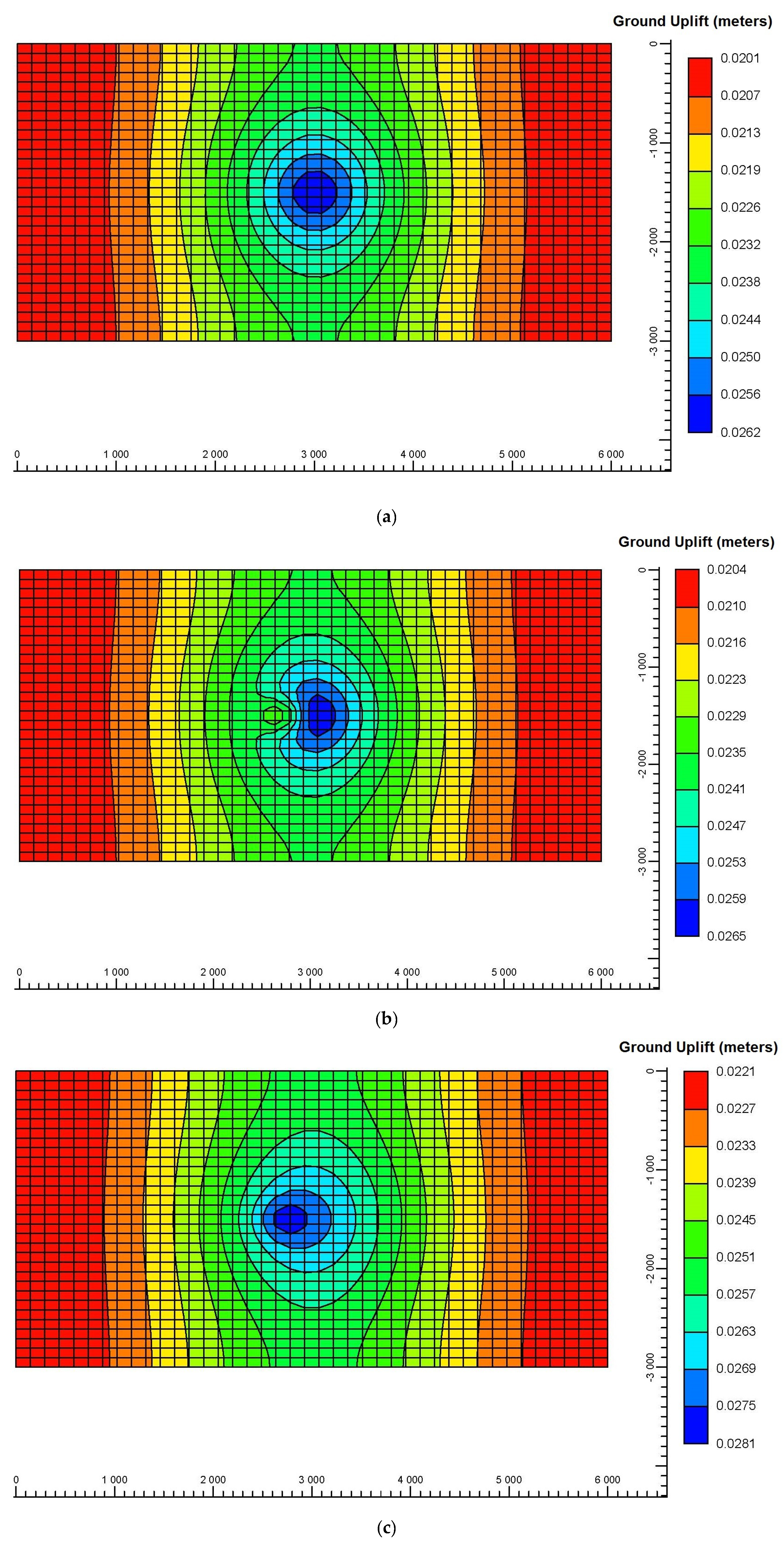
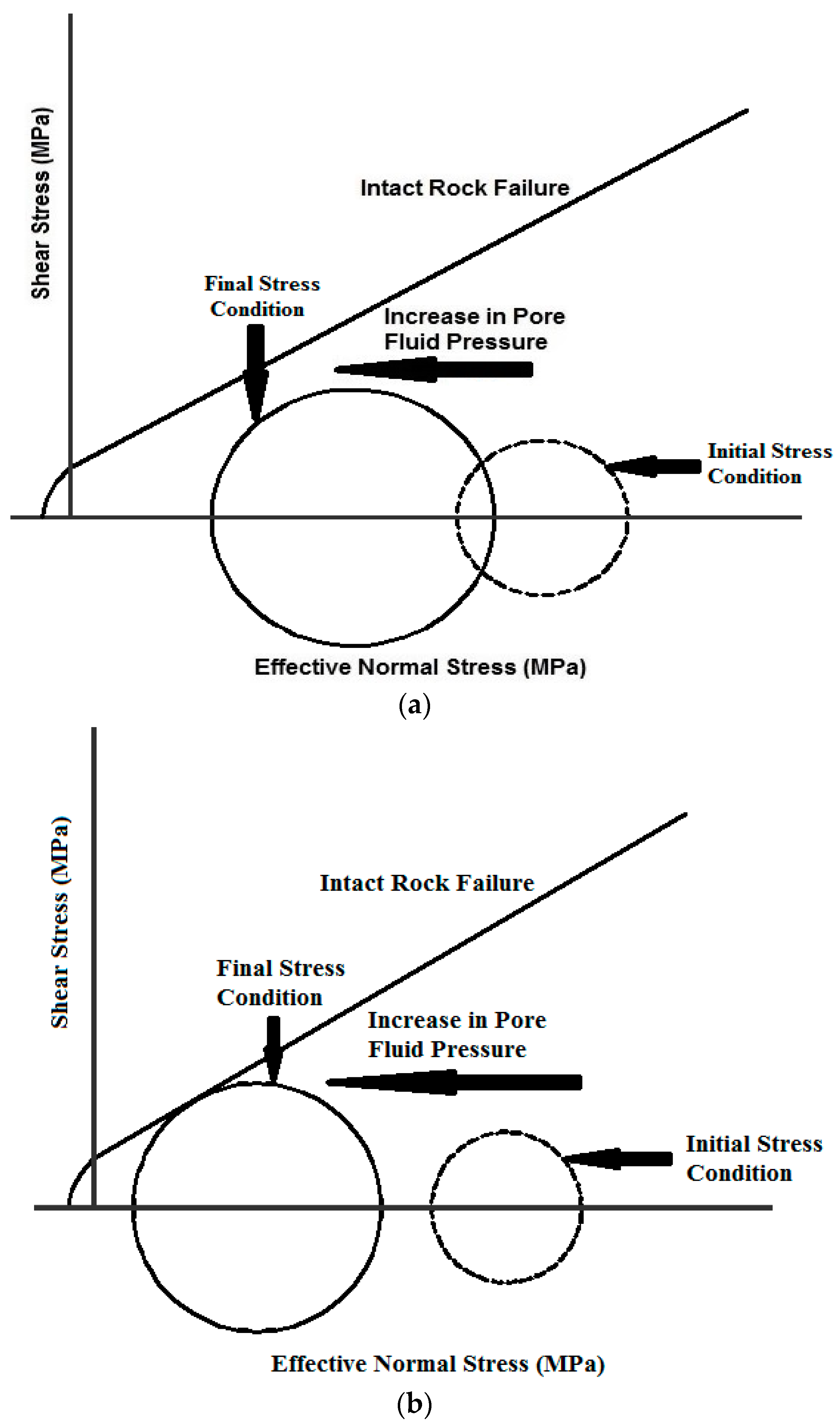
Publisher’s Note: MDPI stays neutral with regard to jurisdictional claims in published maps and institutional affiliations. |
© 2020 by the authors. Licensee MDPI, Basel, Switzerland. This article is an open access article distributed under the terms and conditions of the Creative Commons Attribution (CC BY) license (http://creativecommons.org/licenses/by/4.0/).
Share and Cite
Khan, S.; Khulief, Y.; Al-Shuhail, A.; Bashmal, S.; Iqbal, N. The Geomechanical and Fault Activation Modeling during CO2 Injection into Deep Minjur Reservoir, Eastern Saudi Arabia. Sustainability 2020, 12, 9800. https://doi.org/10.3390/su12239800
Khan S, Khulief Y, Al-Shuhail A, Bashmal S, Iqbal N. The Geomechanical and Fault Activation Modeling during CO2 Injection into Deep Minjur Reservoir, Eastern Saudi Arabia. Sustainability. 2020; 12(23):9800. https://doi.org/10.3390/su12239800
Chicago/Turabian StyleKhan, Sikandar, Yehia Khulief, Abdullatif Al-Shuhail, Salem Bashmal, and Naveed Iqbal. 2020. "The Geomechanical and Fault Activation Modeling during CO2 Injection into Deep Minjur Reservoir, Eastern Saudi Arabia" Sustainability 12, no. 23: 9800. https://doi.org/10.3390/su12239800
APA StyleKhan, S., Khulief, Y., Al-Shuhail, A., Bashmal, S., & Iqbal, N. (2020). The Geomechanical and Fault Activation Modeling during CO2 Injection into Deep Minjur Reservoir, Eastern Saudi Arabia. Sustainability, 12(23), 9800. https://doi.org/10.3390/su12239800





